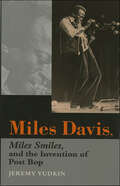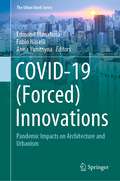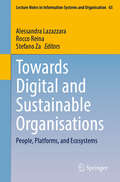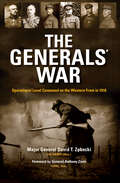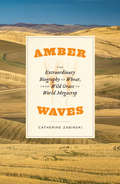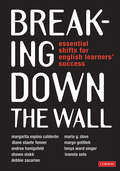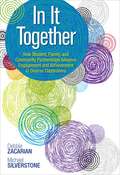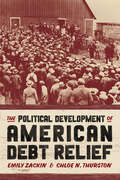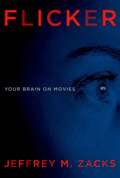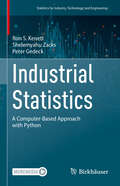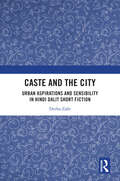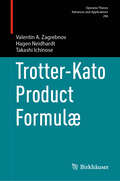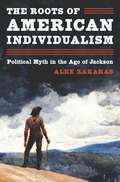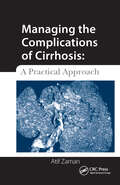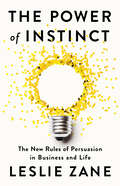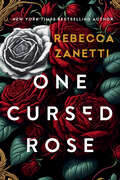- Table View
- List View
Miles Davis, Miles Smiles, and the Invention of Post Bop
by Jeremy YudkinFocusing on one of the legendary musicians in jazz, this book examines Miles Davis's often overlooked music of the mid-1960s with a close examination of the evolution of a new style: post bop. Jeremy Yudkin traces Davis's life and work during a period when the trumpeter was struggling with personal and musical challenges only to emerge once again as the artistic leader of his generation.A major force in post-war American jazz, Miles Davis was a pioneer of cool jazz, hard bop, and modal jazz in a variety of small group formats. The formation in the mid-1960s of the Second Quintet with Wayne Shorter, Herbie Hancock, Ron Carter, and Tony Williams was vital to the invention of the new post bop style. Yudkin illustrates and precisely defines this style with an analysis of the 1966 classic Miles Smiles.
Four Fairies Tell Tales: Don't let the world confine you by defining who you should be
by Samson Yung-Abu“Disability has nothing on ability when ingenuity and agility is shield with a strong belief to achieve and a strong support to try.” In Four Fairies Tell Tales, classic fairy tales are reimagined with a fresh, inclusive twist for the modern age. Three beloved stories are retold, while one original tale makes its debut, each featuring a main character with a common mental or physical challenge. These characters embody bravery, strength, and mental agility, proving that having a ‘disability’ is not a drawback or weakness. Through their unique perspectives and ingenious problem-solving, the characters in these stories tackle challenges head-on, demonstrating that obstacles can be overcome regardless of one’s abilities. By representing and supporting the diverse culture of our modern age, Four Fairies Tell Tales aims to create a more inclusive society for all. This collection of stories celebrates the power of determination and resilience, reminding readers that a disability should never hold one back from achieving their goals and living life to the fullest.
COVID-19: Pandemic Impacts on Architecture and Urbanism (The Urban Book Series)
by Anna Yunitsyna Edmond Manahasa Fabio NaselliThis book gives an overview of the shifting paradigm from traditional design techniques and standards to new values and methods that occurred in response to confronting the COVID-19 pandemic. The theoretical studies of the phenomenon of "new normality" in architecture, urbanism and social sciences are a source of knowledge for researchers, professors and students in the fields of architecture, urbanism and interior design. On-site applications of post-COVID-19 structures will be interesting for students, practitioners, developers and city managers. The issue of online design teaching and learning provides a set of practices that can be applied by both educators and trainees. The book also is useful for readers who are interested in recent trends in architecture and interior design: it provides a deep analysis of recent changes in architecture, which aim to make the environment disease-free and the space habitable during the long periods of lockdown.
Towards Digital and Sustainable Organisations: People, Platforms, and Ecosystems (Lecture Notes in Information Systems and Organisation #65)
by Stefano Za Alessandra Lazazzara Rocco ReinaThis book presents a collection of research papers that explore how ICT experts, managers, and policymakers can address sustainability issues in digital transformation (DT) by considering people practices, organizational processes, and platform design issues. Each chapter offers insights into how to create sustainable digital solutions that benefit both society and the environment. The diversity of views presented makes this book particularly relevant for scholars, companies, and public sector organizations. The content is based on revised versions of selected papers (original double-blind peer-reviewed contributions) presented at the annual conference of the Italian Chapter of AIS, which took place in Catanzaro, Italy, in October 2022.
The Generals' War: Operational Level Command on the Western Front in 1918 (Twentieth-Century Battles)
by Major General David T. ZabeckiKnown as the War to End all Wars and the Great War, World War I introduced new forms of mass destruction and modern technological warfare. When the Bolsheviks pulled Russia out of the war in late 1917, the Germans turned their offensive efforts to the Western Front in an attempt to win the war in 1918. But as fresh American troops entered Europe, the strategic scales tipped against Germany.Much of how World War I played out turned on the plans and decisions of the senior-most German and Allied commanders. The Generals' War explores the military strategies of those generals during the last year of the Great War. These six very different men included Germany's Field Marshal Paul von Hindenburg and General Erich Ludendorff; France's Marshals Ferdinand Foch and Philippe Pétain; Great Britain's Field Marshal Sir Douglas Haig; and the United States' General John Pershing. Although history remembers none of them as great captains, these six officers determined for better or worse how World War I was fought on the battlefields of the Western Front between November 1917 and November 1918.The Generals' War is a landmark exploration of the generalship that shaped the very framework of modern warfare as we know it today and provides a comprehensive and detailed analysis on the senior commanders of the Great War.
Amber Waves: The Extraordinary Biography of Wheat, from Wild Grass to World Megacrop
by Catherine ZabinskiA biography of a staple grain we often take for granted, exploring how wheat went from wild grass to a world-shaping crop. At breakfast tables and bakeries, we take for granted a grain that has made human civilization possible, a cereal whose humble origins belie its world-shaping power: wheat. Amber Waves tells the story of a group of grass species that first grew in scattered stands in the foothills of the Middle East until our ancestors discovered their value as a source of food. Over thousands of years, we moved their seeds to all but the polar regions of Earth, slowly cultivating what we now know as wheat, and in the process creating a world of cuisines that uses wheat seeds as a staple food. Wheat spread across the globe, but as ecologist Catherine Zabinski shows us, a biography of wheat is not only the story of how plants ensure their own success: from the earliest bread to the most mouthwatering pasta, it is also a story of human ingenuity in producing enough food for ourselves and our communities. Since the first harvest of the ancient grain, we have perfected our farming systems to grow massive quantities of food, producing one of our species’ global mega crops—but at a great cost to ecological systems. And despite our vast capacity to grow food, we face problems with undernourishment both close to home and around the world. Weaving together history, evolution, and ecology, Zabinski’s tale explores much more than the wild roots and rise of a now-ubiquitous grain: it illuminates our complex relationship with our crops, both how we have transformed the plant species we use as food, and how our society—our culture—has changed in response to the need to secure food sources. From the origins of agriculture to gluten sensitivities, from our first selection of the largest seeds from wheat’s wild progenitors to the sequencing of the wheat genome and genetic engineering, Amber Waves sheds new light on how we grow the food that sustains so much human life.
Sustainable Business in the Era of Digital Transformation: Strategic and Entrepreneurial Perspectives (ISSN)
by Vesna Zabkar Marek Ćwiklicki Mariusz Sołtysik Magdalena Wojnarowska Maria Urbaniec Erica VareseSustainable development is a complex issue and despite many studies and publications in recent years, it remains poorly recognised on best practices in core business areas. Achieving the Sustainable Development Goals in accordance with the 2030 Agenda for Sustainable Development depends on research and innovation. Therefore, the transition to sustainable development requires investment in technology, new business models, and social and environmental innovations that contribute to shaping new business and promoting sustainable business practices.This book seeks to understand how sustainability affects core business areas, with a focus on strategic and entrepreneurial activities. Given these considerations, the main purpose of this book is twofold: (1) to contribute to a better understanding of important and current trends in the field of sustainable transformation in core business areas; and (2) to provide a comprehensive overview of quantitative and qualitative studies in the field. The book ultimately seeks to shed light on how companies are implementing sustainable transformation in the core areas of product and marketing, entrepreneurship, and innovation, which is supported by appropriate project management strategies.The book provides researchers and upper-level students in economics, business, and other social sciences with an overview of interdisciplinary theoretical and conceptual perspectives and frameworks for successful business transformation. It will be of particular value to those researching sustainable development and strategic management.
Beyond Crises: Overcoming Linguistic and Cultural Inequities in Communities, Schools, and Classrooms
by Debbie Zacarian Margarita Espino Calderon Margo GottliebWhat are some lessons learned from the pandemic? We learned that, in times of crises, the humanitarian needs of students, families, and ourselves must be a top priority. We learned that forming effective partnerships with families and communities is essential to the health and well-being of our children. We were offered a blunt reminder that a system designed to serve the interests of a privileged few was destined to fail our historically underserved students, especially our millions of multilingual learners. Above all, we learned that the "normal" many of us have yearned for was never good enough—that we must envision a "better world," where we build on our multilingual students’ unique assets and cultivate their inner brilliance. Only then will we deliver on their promise. It’s this "better world," a world in which communities, schools, and classrooms work together as a "whole-child ecosystem," Beyond Crises: Overcoming Linguistic and Cultural Inequities in Communities, Schools, and Classrooms sets out to create. Taking a look from the outside in, Debbie Zacarian, Margarita Calderón, and Margo Gottlieb address three critical arenas: 1. Imagining Communities describes how to design and enact strengths-based family and community partnerships, including the critical importance of identifying, valuing, and acknowledging each member’s assets and competencies, and the ways recent crises have amplified their struggles. 2. Imagining Schools takes an up-close look at policies, structures, and now irrelevant ways of schooling that call for change and how we might reconfigure professional development to ensure every teacher and administrator is dedicated to the well-being and success of our multilingual learners. 3. Imagining Classrooms demonstrates how to optimize learning opportunities—both virtual and face-to-face—so our diverse students grow cognitively, linguistically, and social-emotionally, and accentuate their talents in knowing and using multiple languages in linguistically and culturally sustainable environments. "Student and family, classroom, school, and local community are not silos unto themselves," Debbie, Margarita, and Margo insist. "They are part of a larger whole that is interrelated and interconnected and, even, interdependent on each other. By forming stronger alliances, we can realize the power of truly working, socializing, and flourishing together." Beyond Crises is the first critical step forward.
Beyond Crises: Overcoming Linguistic and Cultural Inequities in Communities, Schools, and Classrooms
by Debbie Zacarian Margarita Espino Calderon Margo GottliebWhat are some lessons learned from the pandemic? We learned that, in times of crises, the humanitarian needs of students, families, and ourselves must be a top priority. We learned that forming effective partnerships with families and communities is essential to the health and well-being of our children. We were offered a blunt reminder that a system designed to serve the interests of a privileged few was destined to fail our historically underserved students, especially our millions of multilingual learners. Above all, we learned that the "normal" many of us have yearned for was never good enough—that we must envision a "better world," where we build on our multilingual students’ unique assets and cultivate their inner brilliance. Only then will we deliver on their promise. It’s this "better world," a world in which communities, schools, and classrooms work together as a "whole-child ecosystem," Beyond Crises: Overcoming Linguistic and Cultural Inequities in Communities, Schools, and Classrooms sets out to create. Taking a look from the outside in, Debbie Zacarian, Margarita Calderón, and Margo Gottlieb address three critical arenas: 1. Imagining Communities describes how to design and enact strengths-based family and community partnerships, including the critical importance of identifying, valuing, and acknowledging each member’s assets and competencies, and the ways recent crises have amplified their struggles. 2. Imagining Schools takes an up-close look at policies, structures, and now irrelevant ways of schooling that call for change and how we might reconfigure professional development to ensure every teacher and administrator is dedicated to the well-being and success of our multilingual learners. 3. Imagining Classrooms demonstrates how to optimize learning opportunities—both virtual and face-to-face—so our diverse students grow cognitively, linguistically, and social-emotionally, and accentuate their talents in knowing and using multiple languages in linguistically and culturally sustainable environments. "Student and family, classroom, school, and local community are not silos unto themselves," Debbie, Margarita, and Margo insist. "They are part of a larger whole that is interrelated and interconnected and, even, interdependent on each other. By forming stronger alliances, we can realize the power of truly working, socializing, and flourishing together." Beyond Crises is the first critical step forward.
Breaking Down the Wall: Essential Shifts for English Learners’ Success
by Debbie Zacarian Maria G. Dove Margarita Espino Calderon Diane Staehr Fenner Tonya W. Singer Margo Gottlieb Ivannia Soto Shawn M. Sinclair-Slakk Andrea HonigsfeldIt was a dark and stormy night in Santa Barbara. January 19, 2017. The next day’s inauguration drumroll played on the evening news. Huddled around a table were nine Corwin authors and their publisher, who together have devoted their careers to equity in education. They couldn’t change the weather, they couldn’t heal a fractured country, but they did have the power to put their collective wisdom about EL education upon the page to ensure our multilingual learners reach their highest potential. Proudly, we introduce you now to the fruit of that effort: Breaking Down the Wall: Essential Shifts for English Learners’ Success. In this first-of-a-kind collaboration, teachers and leaders, whether in small towns or large urban centers, finally have both the research and the practical strategies to take those first steps toward excellence in educating our culturally and linguistically diverse children. It’s a book to be celebrated because it means we can throw away the dark glasses of deficit-based approaches and see children who come to school speaking a different home language for what they really are: learners with tremendous assets. The authors’ contributions are arranged in nine chapters that become nine tenets for teachers and administrators to use as calls to actions in their own efforts to realize our English learners’ potential: 1. From Deficit-Based to Asset-Based 2. From Compliance to Excellence 3. From Watering Down to Challenging 4. From Isolation to Collaboration 5. From Silence to Conversation 6. From Language to Language, Literacy, and Content 7. From Assessment of Learning to Assessment for and as Learning 8. From Monolingualism to Multilingualism 9. From Nobody Cares to Everyone/Every Community Cares Read this book; the chapters speak to one another, a melodic echo of expertise, classroom vignettes, and steps to take. To shift the status quo is neither fast nor easy, but there is a clear process, and it’s laid out here in Breaking Down the Wall. To distill it into a single line would go something like this: if we can assume mutual ownership, if we can connect instruction to all children’s personal, social, cultural, and linguistic identities, then all students will achieve.
Breaking Down the Wall: Essential Shifts for English Learners’ Success
by Debbie Zacarian Maria G. Dove Margarita Espino Calderon Diane Staehr Fenner Tonya W. Singer Margo Gottlieb Ivannia Soto Shawn M. Sinclair-Slakk Andrea HonigsfeldIt was a dark and stormy night in Santa Barbara. January 19, 2017. The next day’s inauguration drumroll played on the evening news. Huddled around a table were nine Corwin authors and their publisher, who together have devoted their careers to equity in education. They couldn’t change the weather, they couldn’t heal a fractured country, but they did have the power to put their collective wisdom about EL education upon the page to ensure our multilingual learners reach their highest potential. Proudly, we introduce you now to the fruit of that effort: Breaking Down the Wall: Essential Shifts for English Learners’ Success. In this first-of-a-kind collaboration, teachers and leaders, whether in small towns or large urban centers, finally have both the research and the practical strategies to take those first steps toward excellence in educating our culturally and linguistically diverse children. It’s a book to be celebrated because it means we can throw away the dark glasses of deficit-based approaches and see children who come to school speaking a different home language for what they really are: learners with tremendous assets. The authors’ contributions are arranged in nine chapters that become nine tenets for teachers and administrators to use as calls to actions in their own efforts to realize our English learners’ potential: 1. From Deficit-Based to Asset-Based 2. From Compliance to Excellence 3. From Watering Down to Challenging 4. From Isolation to Collaboration 5. From Silence to Conversation 6. From Language to Language, Literacy, and Content 7. From Assessment of Learning to Assessment for and as Learning 8. From Monolingualism to Multilingualism 9. From Nobody Cares to Everyone/Every Community Cares Read this book; the chapters speak to one another, a melodic echo of expertise, classroom vignettes, and steps to take. To shift the status quo is neither fast nor easy, but there is a clear process, and it’s laid out here in Breaking Down the Wall. To distill it into a single line would go something like this: if we can assume mutual ownership, if we can connect instruction to all children’s personal, social, cultural, and linguistic identities, then all students will achieve.
In It Together: How Student, Family, and Community Partnerships Advance Engagement and Achievement in Diverse Classrooms
by Debbie Zacarian Michael A. SilverstoneHarness the power of teacher, student, school, family, and community partnerships to promote student success Teaching effectively in diverse classrooms has become more complex than ever. The authors of this practical, compelling, and inspiring book propose that understanding the spheres of influence that connect students with teachers, peers, family members, and the broader community significantly increases the odds that every student will succeed in school. In clear, practitioner-friendly language with examples from an inspiring range of K-12 educators, the authors explore how tapping into the rich resources of teachers, students, families, the school community and the community-at-large can make the work of learning more successful for all involved. Richly detailed vignettes and concrete, evidence-based strategies help you systematically: Build coalitions of support around learning and engagement Develop positive relationships with students, their families and their communities Foster positive, reciprocal partnerships Promote peer-to-peer relationship building Support students and families from marginalized populations Learn to draw from the rich resources found within your learning community to build bridges to academic success for all learners. This comprehensive book shows you how! "Building meaningful relationships in education can be difficult, particularly when the parties involved are different from one another in identity, experience, and other ways. As a result, although in principle collaborations and partnerships in education are universally lauded, in practice they are often ignored. What we need are examples of partnerships that work. In it Together by Debbie Zacarain and Michael Silverstone suggests productive ways to work with, learn from, and form authentic relationships with diverse communities. Combining their abundant experience in classrooms and schools, and using examples from caring teachers in diverse classrooms, the authors demonstrate what it means to really be "in it together." Teachers, administrators, and everyone who cares about the future of education in a diverse society will benefit from the strategies they suggest." —Sonia Nieto, Professor Emerita University of Massachusetts
In It Together: How Student, Family, and Community Partnerships Advance Engagement and Achievement in Diverse Classrooms
by Debbie Zacarian Michael A. SilverstoneHarness the power of teacher, student, school, family, and community partnerships to promote student success Teaching effectively in diverse classrooms has become more complex than ever. The authors of this practical, compelling, and inspiring book propose that understanding the spheres of influence that connect students with teachers, peers, family members, and the broader community significantly increases the odds that every student will succeed in school. In clear, practitioner-friendly language with examples from an inspiring range of K-12 educators, the authors explore how tapping into the rich resources of teachers, students, families, the school community and the community-at-large can make the work of learning more successful for all involved. Richly detailed vignettes and concrete, evidence-based strategies help you systematically: Build coalitions of support around learning and engagement Develop positive relationships with students, their families and their communities Foster positive, reciprocal partnerships Promote peer-to-peer relationship building Support students and families from marginalized populations Learn to draw from the rich resources found within your learning community to build bridges to academic success for all learners. This comprehensive book shows you how! "Building meaningful relationships in education can be difficult, particularly when the parties involved are different from one another in identity, experience, and other ways. As a result, although in principle collaborations and partnerships in education are universally lauded, in practice they are often ignored. What we need are examples of partnerships that work. In it Together by Debbie Zacarain and Michael Silverstone suggests productive ways to work with, learn from, and form authentic relationships with diverse communities. Combining their abundant experience in classrooms and schools, and using examples from caring teachers in diverse classrooms, the authors demonstrate what it means to really be "in it together." Teachers, administrators, and everyone who cares about the future of education in a diverse society will benefit from the strategies they suggest." —Sonia Nieto, Professor Emerita University of Massachusetts
The Political Development of American Debt Relief
by Emily Zackin Chloe N. ThurstonA political history of the rise and fall of American debt relief. Americans have a long history with debt. They also have a long history of mobilizing for debt relief. Throughout the nineteenth century, indebted citizens demanded government protection from their financial burdens, challenging readings of the Constitution that exalted property rights at the expense of the vulnerable. Their appeals shaped the country’s periodic experiments with state debt relief and federal bankruptcy law, constituting a pre-industrial safety net. Yet, the twentieth century saw the erosion of debtor politics and the eventual retrenchment of bankruptcy protections. The Political Development of American Debt Relief traces how geographic, sectoral, and racial politics shaped debtor activism over time, enhancing our understanding of state-building, constitutionalism, and social policy.
Flicker: Your Brain On Movies
by Jeffrey ZacksHow is it that a patch of flickering light on a wall can produce experiences that engage our imaginations and can feel totally real? From the vertigo of a skydive to the emotional charge of an unexpected victory or defeat, movies give us some of our most vivid experiences and most lasting memories. They reshape our emotions and worldviews--but why? In Flicker, Jeff Zacks delves into the history of cinema and the latest research to explain what happens between your ears when you sit down in the theatre and the lights go out. Some of the questions Flicker answers: Why do we flinch when Rocky takes a punch in Sylvester Stallone's movies, duck when the jet careens towards the tower in Airplane, and tap our toes to the dance numbers in Chicago or Moulin Rouge? Why do so many of us cry at the movies? What's the difference between remembering what happened in a movie and what happened in real life--and can we always tell the difference? To answer these questions and more, Flicker gives us an engaging, fast-paced look at what happens in your head when you watch a movie.
Industrial Statistics: A Computer-Based Approach with Python (Statistics for Industry, Technology, and Engineering)
by Shelemyahu Zacks Ron S. Kenett Peter GedeckThis innovative textbook presents material for a course on industrial statistics that incorporates Python as a pedagogical and practical resource. Drawing on many years of teaching and conducting research in various applied and industrial settings, the authors have carefully tailored the text to provide an ideal balance of theory and practical applications. Numerous examples and case studies are incorporated throughout, and comprehensive Python applications are illustrated in detail. A custom Python package is available for download, allowing students to reproduce these examples and explore others.The first chapters of the text focus on the basic tools and principles of process control, methods of statistical process control (SPC), and multivariate SPC. Next, the authors explore the design and analysis of experiments, quality control and the Quality by Design approach, computer experiments, and cybermanufacturing and digital twins. The text then goes on to cover reliability analysis, accelerated life testing, and Bayesian reliability estimation and prediction. A final chapter considers sampling techniques and measures of inspection effectiveness. Each chapter includes exercises, data sets, and applications to supplement learning.Industrial Statistics: A Computer-Based Approach with Python is intended for a one- or two-semester advanced undergraduate or graduate course. In addition, it can be used in focused workshops combining theory, applications, and Python implementations. Researchers, practitioners, and data scientists will also find it to be a useful resource with the numerous applications and case studies that are included. A second, closely related textbook is titled Modern Statistics: A Computer-Based Approach with Python. It covers topics such as probability models and distribution functions, statistical inference and bootstrapping, time series analysis and predictions, and supervised and unsupervised learning. These texts can be used independently or for consecutive courses.This book is part of an impressive and extensive write up enterprise (roughly 1,000 pages!) which led to two books published by Birkhäuser. This book is on Industrial Statistics, an area in which the authors are recognized as major experts. The book combines classical methods (never to be forgotten!) and “hot topics” like cyber manufacturing, digital twins, A/B testing and Bayesian reliability. It is written in a very accessible style, focusing not only on HOW the methods are used, but also on WHY. In particular, the use of Python, throughout the book is highly appreciated. Python is probably the most important programming language used in modern analytics. The authors are warmly thanked for providing such a state-of-the-art book. It provides a comprehensive illustration of methods and examples based on the authors longstanding experience, and accessible code for learning and reusing in classrooms and on-site applicationsProfessor Fabrizio RuggeriResearch Director at the National Research Council, ItalyPresident of the International Society for Business and Industrial Statistics (ISBIS)Editor-in-Chief of Applied Stochastic Models in Business and Industry (ASMBI)
Caste and the City: Urban Aspirations and Sensibility in Hindi Dalit Short Fiction
by Deeba ZafirThis book looks at Dalits in the city and examines the nature of Dalit aspirations as well as the making of an urban sensibility through an analysis of hitherto unexamined short stories of some of the first- and second-generation as well as contemporary Dalit writers in Hindi.Tracing the origins of the emergence of Dalit critical consciousness to the arrival of the Dalits into the print medium, after their migration to the city, this book examines their transactions with modernity and the emancipatory promises it held out to them. It highlights the literary tropes that mark their fiction, specifically those short stories which take up urban themes, and shows how even in seemingly caste-neutral spaces caste discrimination is present. The book also undertakes an examination of the stories by contemporary Dalit women writers in Hindi – Rajat Rani Meenu and Anita Bharti – who have posed a radical challenge to both the mainstream feminist movement and the Dalit movement.The volume will be of great interest to scholars and researchers of South Asian literature, especially Hindi literature, Dalit studies, subaltern history, postcolonial studies, political science, and sociology as well as the informed general reader.
Trotter-Kato Product Formulæ (Operator Theory: Advances and Applications #296)
by Valentin A. Zagrebnov Hagen Neidhardt Takashi IchinoseThe book captures a fascinating snapshot of the current state of results about the operator-norm convergent Trotter-Kato Product Formulæ on Hilbert and Banach spaces. It also includes results on the operator-norm convergent product formulæ for solution operators of the non-autonomous Cauchy problems as well as similar results on the unitary and Zeno product formulæ.After the Sophus Lie product formula for matrices was established in 1875, it was generalised to Hilbert and Banach spaces for convergence in the strong operator topology by H. Trotter (1959) and then in an extended form by T. Kato (1978). In 1993 Dzh. L. Rogava discovered that convergence of the Trotter product formula takes place in the operator-norm topology. The latter is the main subject of this book, which is dedicated essentially to the operator-norm convergent Trotter-Kato Product Formulæ on Hilbert and Banach spaces, but also to related results on the time-dependent, unitary and Zeno product formulæ. The book yields a detailed up-to-date introduction into the subject that will appeal to any reader with a basic knowledge of functional analysis and operator theory. It also provides references to the rich literature and historical remarks.
The Roots of American Individualism: Political Myth in the Age of Jackson
by Alex ZakarasA panoramic history of American individualism from its nineteenth-century origins to today’s bitterly divided politicsIndividualism is a defining feature of American public life. Its influence is pervasive today, with liberals and conservatives alike promising to expand personal freedom and defend individual rights against unwanted intrusion, be it from big government, big corporations, or intolerant majorities. The Roots of American Individualism traces the origins of individualist ideas to the turbulent political controversies of the Jacksonian era (1820–1850) and explores their enduring influence on American politics and culture.Alex Zakaras plunges readers into the spirited and rancorous political debates of Andrew Jackson’s America, drawing on the stump speeches, newspaper editorials, magazine articles, and sermons that captivated mass audiences and shaped partisan identities. He shows how these debates popularized three powerful myths that celebrated the young nation as an exceptional land of liberty: the myth of the independent proprietor, the myth of the rights-bearer, and the myth of the self-made man.The Roots of American Individualism reveals how generations of politicians, pundits, and provocateurs have invoked these myths for competing political purposes. Time and again, the myths were used to determine who would enjoy equal rights and freedoms and who would not. They also conjured up heavily idealized, apolitical visions of social harmony and boundless opportunity, typically centered on the free market, that have distorted American political thought to this day.
Connected Medical Devices: Integrating Patient Care Data in Healthcare Systems (HIMSS Book Series)
by John ZaleskiThis book explores how medical device integration (MDI) supports quality patient care and better clinical outcomes by reducing clinical documentation transcription errors, improving data accuracy and density within clinical records and ensuring the complete capture of medical device information on patients. It begins with a comprehensive overview of the types of medical devices in use and the ways in which those devices interact, then examines factors such as interoperability standards, patient identification, clinical alerts and regulatory and security considerations.
Managing the Complications of Cirrhosis: A Practical Approach
by Atif ZamanManaging the Complications of Cirrhosis: A Practical Approach is a simple pocket guide for the community gastroenterologist and primary-care provider who manages liver disease. While there are other books available on the market regarding the management of cirrhosis, this reference includes information geared toward the busy practitioner, allowing the reader to reference a chapter that easily addresses the clinical issue at hand. Dr. Atif Zaman provides essential and current information on the management of cirrhosis for the nonhepatologist.Each chapter in Managing the Complications of Cirrhosis: A Practical Approach is broken down into four sections, including a summary of the issue at hand, a diagnosis of the problem, a treatment algorithm, and what to do if the treatment algorithm is ineffective. In addition, each chapter highlights complex cases that have no standard treatment, but have emerging concepts or data.Chapter topics include:• Preventative health issues in patients with cirrhosis• Nutrition in patients with cirrhosis• Management of hepatocellular carcinoma• Pulmonary issues in patients with cirrhosis• Timing of referral for liver transplantWith algorithms and tables, Managing the Complications of Cirrhosis: A Practical Approach is the perfect book for all community gastroenterologists, primary-care practitioners, medical residents and fellows, physician assistants, and nurse practitioners who provide care in the area of liver disease.
Crossing the Desert: The Power of Embracing Life's Difficult Journeys
by Payam ZamaniAt the age of 16, he escaped persecution and made his way to America as a refugee. At 28, he secured a billion-dollar IPO. Today, he&’s redefining what it means to be an entrepreneur by building a new model of capitalism.In the summer of 1987, Payam Zamani fled Iran. As a member of the Baha&’i Faith, he had already survived years of religious persecution at the hands of Islamic fundamentalists. Taking the only path available to him, he escaped to Pakistan through the Emptiness Desert: a harrowing five-day trek through one of the hottest, driest, and most hostile regions on the planet.Twelve years later, he and his brother set records when the company they founded hit a $1.2 billion valuation on Wall Street. He was rich—on paper. But in the wake of yet another Wall Street meltdown, he learned the hard way that modern capitalism can be harmful to the human soul.In 2015, Payam set the example he wanted to see by merging his business acumen with his spiritual beliefs and founding a new company—One Planet Group—this time without letting Wall Street or the venture capital world dictate the terms. Today, One Planet Group is proving that it&’s not only possible but necessary to build strong businesses while taking care of our employees, customers, communities, and the planet.Crossing the Desert gives readers an intimate look at how the paths we choose, the values we embrace, and the systems we decide to participate in (or not) can make or break us, not only financially, but spiritually. Payam&’s story is a timely reminder that enduring and embracing life&’s most difficult journeys can lead us to a brighter future—not only for ourselves, but for the people around us, and even the world.
The Power of Instinct: The New Rules of Persuasion in Business and Life
by Leslie ZaneAward-winning Fortune 500 brand consultant and behavioral expert Leslie Zane shatters conventional marketing wisdom, showing readers how to tap into the hidden brain where instinct prevails, creating a powerful network of connections that drive people to buy your product, company, or vision. People don&’t make decisions with their conscious mind, but on instinct. In The Power of Instinct, marketing consultant and behavioral science expert Leslie Zane shows that to grow a brand, business, or even a social movement, traditional persuasion tactics fall short. Instead, you must connect to the instinctive mind. And to do this, you need to understand the science of consumer choice and employ techniques that work with a person&’s brain, not against it. Zane uncovers the hidden network of connections that dictates the snap decisions we make and cracks the code on how to influence it. With a revolutionary set of rules for expanding the network, Zane shows us how to make any brand, business, political candidate, or idea the dominant instinctive choice. With science as your guide, as well as stories from the world&’s most successful brands from McDonald's and Lululemon to the Yankees and Taylor Swift, you'll learn: What kind of messages create the greatest amount of positive associations; Why finding new customers accelerates growth and relying on existing ones is a trap; Why emotional stories are not enough to drive trial and long-term brand loyalty. Whether you're an entrepreneur, Fortune 500 executive, marketing professional, or job seeker, mastering the power of instinct will help supercharge your growth and make whatever you&’re selling the first choice for any audience.
One Cursed Rose (Grimm Bargains #1)
by Rebecca ZanettiFor fans of Scarlett St Clair and Sarah J Maas, New York Times bestselling author Rebecca Zanetti explores the forbidden and the taboo in this modern twist on Beauty and the Beast – the first in a seductive new dark romance series set in a world where information is power, and those who control the flow of information live like gods… &“Sexy and utterly engrossing!&” —bestselling author J.T. Geissinger They christened me Alana—and while the name means beauty, beneath that surface is a depth I allow very few to see. I&’m sole heir to Aquarius Social, a media giant about to succumb to an unseen enemy. My father&’s solution is to marry me off to the son of a competing family. My reaction? Not a chance. Now I have just a week before the wedding to change my fate. Who knew the unforeseen twist would be an assassination attempt on me and an unwanted rescue by Thorn Beathach, the head of the rival social media empire driving Aquarius under? The richest, most ruthless of them all, the Beast protects his realm with an iron rule: no one sees his face. When he shows himself to me, I know he&’ll never let me go. Thorn may think he can lock me in his enchanted castle forever, but I&’m not the docile Beauty he expects. If the Beast wants to tie me up, I&’m going to take pleasure from every minute of it . . .and we&’ll just see who ends up shackled.
One Cursed Rose: The captivating dark romantasy inspired by Beauty and the Beast
by Rebecca ZanettiFor fans of Scarlett St Clair and Sarah J Maas, New York Times bestselling author Rebecca Zanetti explores the forbidden and the taboo in this twist on Beauty and the Beast - the first in a seductive new dark romance series set in a world where information is power, and those who control the flow of information live like gods...'Sexy and utterly engrossing!' J.T. Geissinger'Zanetti launches a new series with this shadowy and violent twist on "Beauty and the Beast" that will appeal to readers looking for a uniquely magical world filled with seduction and betrayal' Library Journal _________________________Anyone can be swallowed by the darkest of shadows . . .Alana Beaumont is the sole heir to Aquarius Social - but with the company under attack from an unseen enemy, her father decides to marry her off to a rival family in the hopes of securing an alliance, leaving Alana torn between her family duty and her thirst for revenge as her wedding day approaches.But, following an unsuccessful assassination attempt, the wedding becomes the least of her concerns when she comes face to face with her rescuer: Thorn Beathach, owner of the rival business empire driving Aquarius under . . . and now her kidnapper.Known as the richest and most ruthless of them all, Thorn protects his realm with an iron fist, and no one sees his face. Until Alana.Convinced that she is only safe with him, Thorn wants to keep her in his enchanted castle forever, but she's not the docile beauty he expects, and he's not the only one who will find pleasure in their arrangement . . .
